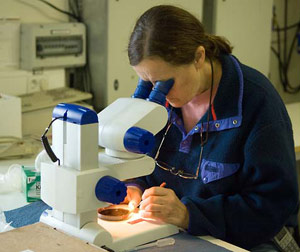|
Interview with Susan Humphris by Lonny Lippsett, photo by Chris Linder
Hydrothermal vents are similar to the geysers at Yellowstone National Park, but on the bottom of the ocean. There is hot magma, or molten rock, beneath Yellowstone, and rainwater that percolates into the ground gets heated up and becomes buoyant and rises back to the surface. In the ocean, it’s similar. There’s a chain of volcanoes through the middle the ocean called the mid-ocean ridge. Seawater percolates down through cracks in the seafloor along the ridge and gets heated by magma or hot, solid rock. The hot fluids rise and discharge at the seafloor. But the fluids that come out of the seafloor are not the same as when they went in, correct? A great deal of chemistry goes on in between the time seawater goes in and the hydrothermal fluids emerge back out of the seafloor. The seawater that goes down into ocean crust rocks reacts chemically with those rocks. As you go deeper down, temperatures get higher, which catalyzes other chemical reactions, and all these reactions change the fluids’ chemistry. What do you start and end up with? We start with cold, alkaline oxygenated seawater, but it is chemically transformed into fluids that have no oxygen and are very acidic. These fluids actually remove metals such as iron, copper, and zinc from the rocks. The fluids that come back up to the surface have a lot of these metals dissolved in them. And they’re very hot—about 350° to 400° Celsius, or 650° to 750° Fahrenheit. What happens when the hydrothermal fluids come out of the seafloor? They mix with cold seawater and become colder and oxygenated. The metals in the fluids precipitate out as solid iron, copper, and zinc sulfides. So vent systems actually remove metals from ocean crust and concentrate them into large metal-rich deposits. And the other thing that’s produced during this process is hydrogen sulfide, which organsims around the vents uses for energy. How did you begin to study hydrothermal vents? When I was a graduate student in the MIT/WHOI Joint Program, there was evidence that hydrothermal vents had to exist on the seafloor, but nobody had actually found one. I was lucky enough to have an advisor who had dredged up some volcanic rocks from the mid-ocean ridge. The rocks clearly contained minerals that were formed by high-temperature chemical reactions with seawater. My thesis research involved analyzing the chemical reactions between the water and rocks that would produce the minerals that I saw in the rocks. And to figure out what the chemistry of the fluids produced by such reactions might be—if there were such things as hydrothermal vents. Fortunately for me, about six months later, hydrothermal vents were discovered in 1977. Are all hydrothermal vent sites similar? No, depending on the temperature and the types of rocks at different vents sites, you get different chemical reactions, and therefore different sorts of mineral deposits. At vents with high temperatures, we get sulfide deposits. Low-temperature vents are made up of many different minerals depending on the rock type. These include calcium carbonate, clay minerals, and iron-manganese deposits. We’re not sure what we’re going to find at the Gakkel Ridge. What’s so special about the Gakkel Ridge? The Gakkel Ridge is one of the slowest-spreading ridges along the mid-ocean-ridge system. That means there is less volcanic activity, which means that along some parts of the Gakkel Ridge, there isn’t a volcanic layer on the seafloor. Instead, rocks from the a deeper layer in the the Earth, called the mantle, are exposed along the Gakkel Ridge. Now mantle rocks have a very different chemistry, and hence the chemical reactions that go on between seawater and those rocks are different, and they produce different mineral elements. And they produce different gases that organisms around the vents use as their energy source. Consequently we might have different types of mineral deposits and different types of organisms along the Gakkel Ridge, perhaps some that we’ve never seen before. Anything else that’s distinctive about the Gakkel Ridge? Another reason it’s intriguing is that the type of rock we expect to find on the Gakkel Ridge is very similar in chemistry to the rock chemistry that we believe existed on Earth billions of years ago when the planet was young. So the Gakkel Ridge is the closest situation we have to investigate the early volcanism that shaped our planet, and perhaps the earliest forms of life on Earth. What is your greatest hope for this expedition? That we find a whole range of different types of hydrothermal vents, including some on exposed mantle rock. What is your greatest fear? This is a pretty high-risk operation. My fear is that we lose our robotic vehicles under the ice or that we don’t find any vents. That would certainly be a major disappointment. What do you do in your spare time when you have any? Well, believe it or not, I spend a lot of time on the ocean. I fish and shellfish. My husband and I have a small boat. We like to explore the islands all around Woods Hole. I scuba dive, for pleasure only, and swim a lot, so I’m definitely an ocean person. This expedition is scheduled to last six weeks. Can you give us a sense of how many research cruises you’ve been on in your career? The other day I calculated it, and I’ve spent more than three years of my life on research vessels.
|
Mailing List | Feedback | Glossary | For Teachers | About Us | Contact
© 2010 Dive and Discover™. Dive and Discover™ is a registered trademark of Woods
Hole Oceanographic Institution

